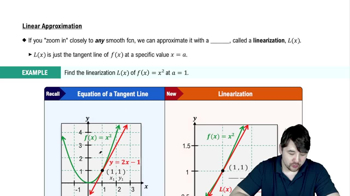Find the linearization of ƒ(x) = √(1 + x) + sin x - 0.5 at x = 0.
Table of contents
- 0. Functions7h 54m
- Introduction to Functions16m
- Piecewise Functions10m
- Properties of Functions9m
- Common Functions1h 8m
- Transformations5m
- Combining Functions27m
- Exponent rules32m
- Exponential Functions28m
- Logarithmic Functions24m
- Properties of Logarithms36m
- Exponential & Logarithmic Equations35m
- Introduction to Trigonometric Functions38m
- Graphs of Trigonometric Functions44m
- Trigonometric Identities47m
- Inverse Trigonometric Functions48m
- 1. Limits and Continuity2h 2m
- 2. Intro to Derivatives1h 33m
- 3. Techniques of Differentiation3h 18m
- 4. Applications of Derivatives2h 38m
- 5. Graphical Applications of Derivatives6h 2m
- 6. Derivatives of Inverse, Exponential, & Logarithmic Functions2h 37m
- 7. Antiderivatives & Indefinite Integrals1h 26m
- 8. Definite Integrals4h 44m
- 9. Graphical Applications of Integrals2h 27m
- 10. Physics Applications of Integrals 3h 16m
- 11. Integrals of Inverse, Exponential, & Logarithmic Functions2h 31m
- 12. Techniques of Integration7h 41m
- 13. Intro to Differential Equations2h 55m
- 14. Sequences & Series5h 36m
- 15. Power Series2h 19m
- 16. Parametric Equations & Polar Coordinates7h 58m
4. Applications of Derivatives
Linearization
Problem 3.9.11
Textbook Question
Linearization for Approximation
In Exercises 7–12, find a linearization at a suitably chosen integer near a at which the given function and its derivative are easy to evaluate.
f(x) = ∛x, a = 8.5
 Verified step by step guidance
Verified step by step guidance1
Identify the function f(x) = ∛x and the point a = 8.5 where you want to approximate the function using linearization.
Choose a nearby integer to a = 8.5 where the function and its derivative are easy to evaluate. In this case, choose a = 8 because ∛8 is easy to compute.
Find the derivative of the function f(x) = ∛x. The derivative f'(x) can be found using the power rule for derivatives. Rewrite ∛x as x^(1/3) and differentiate: f'(x) = (1/3)x^(-2/3).
Evaluate the function and its derivative at the chosen integer a = 8. Calculate f(8) = ∛8 = 2 and f'(8) = (1/3)(8)^(-2/3).
Use the linearization formula L(x) = f(a) + f'(a)(x - a) to approximate the function near x = 8.5. Substitute the values found: L(x) = 2 + f'(8)(x - 8).
 Verified video answer for a similar problem:
Verified video answer for a similar problem:This video solution was recommended by our tutors as helpful for the problem above
Video duration:
3mPlay a video:
Was this helpful?
Key Concepts
Here are the essential concepts you must grasp in order to answer the question correctly.
Linearization
Linearization is a method used to approximate a function near a given point using its tangent line. It involves finding the linear function that best approximates the original function at a specific point, typically where the function and its derivative are easy to evaluate. This technique simplifies complex functions into linear ones, making calculations more manageable.
Recommended video:

Linearization
Derivative
The derivative of a function represents the rate at which the function's value changes with respect to changes in its input. It is a fundamental concept in calculus used to find the slope of the tangent line at any point on the function. For linearization, the derivative is crucial as it provides the slope of the tangent line, which is used to construct the linear approximation.
Recommended video:

Derivatives
Choosing a Suitable Point
Choosing a suitable point near the given value is essential for effective linearization. This point should be an integer where the function and its derivative are easy to compute, ensuring the linear approximation is accurate and calculations are simplified. In this context, selecting a point like x = 8 for f(x) = ∛x allows for straightforward evaluation, as the cube root and its derivative are simple to calculate.
Recommended video:

Critical Points
Related Videos
Related Practice
Textbook Question


